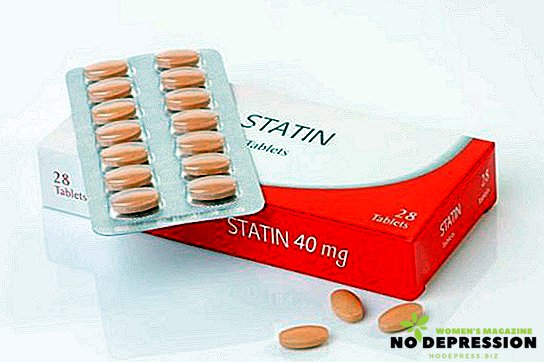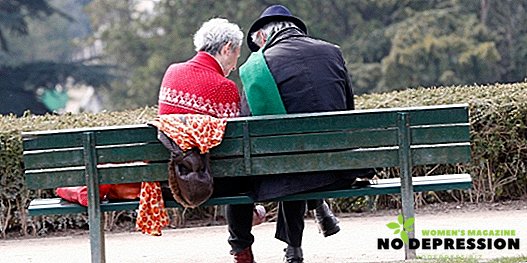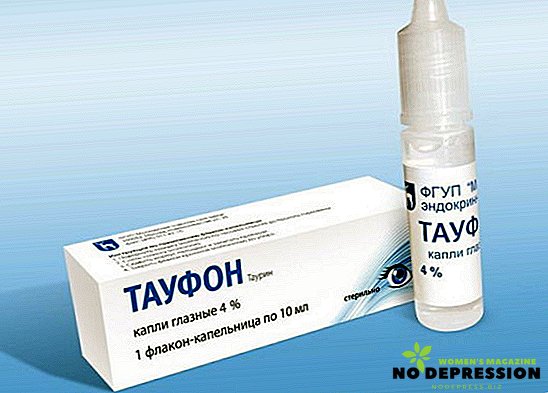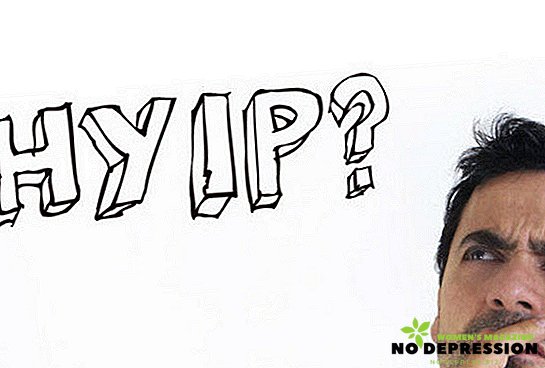Statins - a group of drugs that are used in case of high cholesterol levels. However, it is important to remember that these drugs can cause serious complications. Because it is so important to consult a doctor.

When are statins prescribed?
Before describing in detail the side effects and harm from the use of statins, it is necessary to understand when doctors prescribe such drugs.
Statins are hypolipidemic agents, the mechanism of action of which is associated with the selective inhibition of HMG reductase enzymes. This is a key link in the formation of cholesterol and its fractions.
Indications for use of statins are as follows:
- as part of complex therapy with elevated cholesterol;
- with hereditary forms of hypercholesterolemia;
- for the treatment of fat metabolism in cardiovascular and cerebrovascular pathologies.
Thus, modern medicine recommends taking statins in case of increasing cholesterol levels, regardless of the cause.
Principles of Assignment
 Before using drugs, all patients with high cholesterol should be familiar with the methods of correcting fat metabolism with the help of diets, physical exertion, and rejection of bad habits.
Before using drugs, all patients with high cholesterol should be familiar with the methods of correcting fat metabolism with the help of diets, physical exertion, and rejection of bad habits.
If the cholesterol level does not return to normal within 3-4 months of drug treatment, doctors can prescribe statins. Means based on atorvastatin and simvastatin begin to act after 10-14 days of regular use, on the basis of rosuvastatin - an order of magnitude faster. The maximum therapeutic effect occurs after one month of administration and lasts for the entire course of therapy. Statin therapy is long, can last for a lifetime.
Mechanism of action
Statins act at the biochemical level. They block one of the main enzymes in cholesterol synthesis. Due to this, the drug has the following pharmacological effect:
- the initial cholesterol concentration decreases during the first month;
- production of bad cholesterol decreases;
- increases the concentration of beneficial cholesterol fractions.
In addition, due to an increase in the number of receptors in relation to harmful atherogenic lipids on the surface of the hepatocyte, statins increase their utilization.
Due to this violation, the ratio of high and low density lipoproteins is restored. Atherogenicity returns to normal. The benefit of statins is to reduce the risk of ischemic manifestations in patients with insufficient blood supply to the heart and brain. Cardiovascular disease is prevented in people with risk factors, such as age, smoking, and diabetes. The risk of fatal complications is reduced, the quality of life improves.
Do statins prolong life?
Patients with elevated cholesterol and atherosclerosis often experience complications such as
- myocardial infarction;
- circulatory disorders in the vessels;
- stroke.
All these states are connected by the general mechanism of the development of the pathological process:
- increasing the concentration of total cholesterol and its pyrogenic reactions;
- the deposition of lipids on the walls of blood vessels, their strengthening and the formation of cholesterol plaques;
- circulatory failure due to vasoconstriction.
First of all, the heart muscle and the brain are affected, since it is they who need oxygen and nutrients. The first symptoms of ischemia appear: unpleasantly pressing pains behind the sternum, loss of tolerance to stress during a heart lesion; dizziness and headaches with insufficient oxygen to the brain.
If time does not pay attention to such manifestations, circulatory failure will progress and may cause life-threatening consequences in the form of a heart attack and stroke.
Cardiac muscle infarction is an irreversible physiological change in heart tissue that includes necrosis and aseptic inflammation. This condition is manifested by a sharp pain in the heart, fear of death, panic.
 If necrosis has engulfed the entire wall of the organ, the infarction takes on a transmural shape. With a favorable outcome, the area of necrosis is tightened with connective tissue, resulting in a scar.
If necrosis has engulfed the entire wall of the organ, the infarction takes on a transmural shape. With a favorable outcome, the area of necrosis is tightened with connective tissue, resulting in a scar.
When the damage is too extensive, the heart cannot 100% perform its function of pumping blood. Heart failure occurs, which can be fatal. Stroke can also be fatal, that is, the blood supply to areas of the brain is impaired.
With ischemic damage to vital areas of the brain, death can occur instantaneously. Any dangerous complication of atherosclerosis develops rather suddenly and requires immediate hospitalization.
The use of statins in the prevention and treatment of atherosclerosis is invaluable. Such drugs help keep cholesterol levels in the normal range, prevent the appearance of atherosclerotic plaques, and reduce the risk of heart attack and stroke. In addition, you can reduce the risk of death from repeated heart attacks and strokes in the case of people with high concentrations of cholesterol in the blood.
Is there any harm to these drugs?
20 years ago in medicine there was a real boom for statins: these drugs were prescribed to those whose cholesterol was elevated even slightly, if the condition could be easily corrected with a proper diet.
A few years later, the unwarranted popularity of these drugs began to appear publications on the studies conducted, indicating the negative impact of such drugs on the work of internal organs.
Liver
The liver produces up to 80% of endogenous cholesterol. In the case of the use of statins, the synthesis processes are disturbed, and the effect on hepatocytes is harmful. The main thing is that they destroy the liver cells.
Despite the fact that the liver has an almost inexhaustible ability to regenerate, the dangerous effect of these drugs cannot be denied. However, it is worth noting that the destruction of liver cells does not occur in all patients. To track the damage that statins have, you need to regularly undergo laboratory tests, be tested for liver function tests. It is also recommended to be tested for total protein bilirubin to assess liver function.
With an increase in bilirubin, we can talk about gross violations at the hepatocellular level. In such situations, to assign statins is not recommended. By their chemical and biological nature, ALT and AST are enzymes that enter the bloodstream when liver cells break down. But hepatocytes are constantly being updated: the old ones die off, their place is taken by the new ones.
Therefore, the substance in the minimum concentration should be present in the blood. If for any reason the hepatocytes die, the ALT and AST values will increase several times. With long-term statin intake, liver function tests may exceed normal values by 2–4 times.

Ideal for patients who are just starting to drink statins: to be tested before taking the pills and 1.5-2 months after regular use of drugs.
If ALT and AST are normal according to the results of the first and second tests, the statins do not have a harmful effect on the liver, therapy with them will benefit the body. If, before taking statins, liver function tests were normal, and then increased dramatically, then the harm to the body is significant.
In this case, you should consult with your doctor for further treatment tactics.
Such options are possible:
- Cancel statins. Often, when the concentration of ALT and AST becomes dangerous, the only sure step is the complete abolition of the drug. In order to avoid harm, which in this case is far superior to the benefit, it is recommended to switch to other groups of lipid-lowering drugs, but only after a full reduction of liver function tests to normal. Also, patients should not forget that the main method of treating high cholesterol and atherosclerosis is a proper diet with a minimum fat content, moderate physical activity.
- Dosage adjustment. The dosage regimen of almost all statins is the same: the drug is administered once a day, the minimum recommended dose is 10 mg, the maximum is 80 mg. The process of selecting the appropriate dose for a patient takes a long time: at the beginning of therapy, a minimum dosage is prescribed, several weeks after the start of therapy a control analysis of cholesterol is prescribed - on the basis of it a dosage is prescribed.
The higher the dosage of the drug, the greater the harmful effects of the drug on the internal organs. Therefore, if a patient is prescribed 80 mg of statins, then in the presence of dangerous consequences, the dosage may be reduced, but only after the recommendation of the doctor.
In addition, patients who take statins need to protect the liver from the negative influence of some factors:
- to refuse from bad habits;
- do not take other medications without a doctor's recommendation;
- limit eating fatty fried foods.
Joints and muscles
Another fairly common side effect is the effect of statins on skeletal muscle. So, a number of patients had intense muscle pain, especially in the evening after an active day. The mechanism of development of myalgia is associated with the ability of statins to destroy myocytes, that is, muscle cells.
Instead, inflammation begins - myositis, lactic acid is secreted, which as a result irritates the nerve endings even more. Muscle pain when taking statins is reminiscent of discomfort after hard physical work. Therefore, the muscles of the lower limbs are most often affected.
Most pathophysiological changes that occur in the muscle structure are temporary and disappear completely after the abolition of statins. Rhabdomyolysis is a syndrome that is a critical degree of myositis. It is manifested by a sharp mass death of a large portion of muscle fibers, decomposition products then enter the bloodstream, which leads to the development of renal failure. In other words, the kidneys do not cope with the volumes of toxic substances and refuse to work.
With the development of this patient, the patient must be urgently hospitalized. In order to prevent the development of this syndrome, all patients who take statins, it is necessary to regularly be tested for CPK - an enzyme that is released into the blood during neurosis of muscle tissue.

The norm KFK - 24-180 Me / L. In case of growth of this indicator, it is recommended to abandon statins or reduce the dosage. Less commonly, patients who take these drugs have a dangerous complication on the part of the joints. The main danger of such funds is that they change the amount and physicochemical properties of the intraarticular fluid. For this reason, patients may develop arthritis and arthrosis. If untreated, if the condition progresses, the contracture of the joint may develop, that is, pathological fusion of its key elements. Because of this movement in the joint to make it harder, after a certain period, it can become completely motionless.
Digestive organs
The most common side effect of taking statins is dyspeptic symptoms. In about 3% of cases, while taking these drugs to lower cholesterol, the following symptoms may occur:
- nausea;
- belching;
- increased appetite or refusal to eat;
- stomach ache.
All symptoms indicate the individual sensitivity of the drug, so most often it is necessary to adjust the dose downwards. In rare cases, patients may develop inflammatory or ulcerative damage to the mucous membranes of the mouth, stomach, esophagus, intestines. Treatment of these conditions is carried out according to general principles, statins are canceled during this period.
Nervous system
On the CNS side, taking statins can cause:
- headache;
- insomnia;
- nightmares;
- sleepiness;
- dizziness;
- severe asthenia;
- memory loss;
- sensitivity disorders;
- taste perversions;
- emotional instability, paralysis of the facial nerve, which manifest asymmetry of the face.
However, it should be understood that not every patient can develop such side effects. In general, the frequency does not exceed 2%.
Heart and vessels
 Despite the invaluable benefits that these drugs have on the cardiovascular system, side effects are possible in 2% of cases, which include:
Despite the invaluable benefits that these drugs have on the cardiovascular system, side effects are possible in 2% of cases, which include:
- expansion of peripheral vessels and pressure reduction;
- migraine, which is caused by a change in the tone of the blood vessels of the brain;
- arrhythmia;
- increased manifestations of angina.
However, such side effects are most often associated with the fact that the vessels are rearranged to a new mode of operation after functioning for wear under conditions of chronic oxygen starvation.
Respiratory system
When taking statins from the respiratory system can be observed:
- reduced immunity;
- development of infectious processes;
- progression of the infection or its spread to the lower respiratory tract.
- nasal bleeding;
- kidney and urinary system problems.
Regular intake of statins can cause:
- The development of urogenital infections due to reduced immunity.
- Infection with conditionally pathogenic flora, manifested by cystitis.
- Disorders of the kidneys and the appearance of peripheral edema.
- Changes in urine laboratory tests.
- Allergies. Such a reaction occurs very rarely, but some patients may experience itching, rash, edema, urticaria.
The development of anaphylactic shock and dangerous skin syndromes, other severe pathologies was recorded in isolated cases during post-marketing studies.
How do statins affect the fetus: taking during pregnancy and during lactation
Treatment with statins during pregnancy and feeding is strictly prohibited. In addition, if treatment with these drugs is recommended for women of reproductive age, that is, at the age of 15-45 years before menopause, before taking it, you need to make sure that you are not pregnant, and you need to use effective methods of contraception during treatment.
Statins are those drugs that affect the fetus. At the moment, no studies have been conducted on humans, however, in experiments on laboratory animals, it turned out that the use of statins for pregnant women can cause a significant reduction in the weight of the child. Also, medicine knows the birth of a child with a huge number of malformations after the mother takes statins in the first trimester of pregnancy.
It is worth remembering that normal cholesterol is a necessary substance for the growth and development of the fetus. Statins overcome the hemato-placental barrier and accumulate in the baby’s blood. Since these drugs significantly reduce cholesterol synthesis, the fetus will eventually lack this substance. Statins also penetrate and accumulate in breast milk. Therefore, at the time of therapy, breastfeeding should be stopped.
Features of treatment
Before the doctor selects the necessary drug, it is desirable to undergo a full examination:
- Blood and urine (total).
- Lipidogram, that is, the study of lipid metabolism in the body, which will determine the total cholesterol, its fractions, the risk of developing cardiovascular disease.
- Biochemical analysis of blood, which includes bilirubin, ALT, AST, CK, creatine and urea to determine the work of the kidneys.
If the results obtained are within the normal range, then there are no contraindications to statin administration. After 1 month after the start of admission, it is necessary to go through all the studies to determine further actions. If all indicators are within the normal range, treatment can continue, but if abnormalities in the liver, kidneys, muscles were detected, statin therapy can be canceled.
Do statins accept pros and cons
Despite disputes in the scientific world about the dangers and benefits of statins, doctors daily prescribe these drugs to a large number of people who have high levels of cholesterol in the blood. The table shows all the pros and cons of taking such drugs.
| BEHIND | VS |
| Control of cholesterol levels, a noticeable decrease in this indicator within 1 month. | It can not be used to treat patients with chronic liver disease, since such drugs can cause massive necrosis of hepatocytes. |
| Reducing the risk of developing coronary artery disease. | A large number of side effects. |
| 40% reduced risk of fatal complications of the cardiovascular system. | The frequency of occurrence of side effects is 2%. |
| Reducing mortality from stroke and heart attack. | It can not be used to treat pregnant, lactating women, children under 10 years. |
| Ease of use - just one tablet per day. | It requires a long reception, because of which the risk of side effects increases. |
| The possibility of use in the treatment of atherosclerosis in patients with chronic renal pathology, since the statins are removed by the liver. | Плохое сочетание с другими лекарственными препаратами. |












